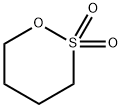1633-83-6

Product Name:
1,4-Butane sultone
Formula:
C4H8O3S
Synonyms:
1,4-Butanesultone;4-Hydroxy-1-butanesulfonic acid δ-sultone;4-Hydroxybutane-1-sulfonic acid δ-sultone
Inquiry
CHEMICAL AND PHYSICAL PROPERTIES
| Physical Description | Liquid |
|---|---|
| Chemical Classes | Other Classes -> Sulfur Compounds |
SAFETY INFORMATION
| Signal word | Warning |
|---|---|
| Pictogram(s) |
 Exclamation Mark Irritant GHS07  Health Hazard GHS08 |
| GHS Hazard Statements |
H302:Acute toxicity,oral H315:Skin corrosion/irritation H317:Sensitisation, Skin H319:Serious eye damage/eye irritation H335:Specific target organ toxicity, single exposure;Respiratory tract irritation H351:Carcinogenicity |
| Precautionary Statement Codes |
P201:Obtain special instructions before use. P280:Wear protective gloves/protective clothing/eye protection/face protection. P301+P312:IF SWALLOWED: call a POISON CENTER or doctor/physician IF you feel unwell. P302+P352:IF ON SKIN: wash with plenty of soap and water. P305+P351+P338:IF IN EYES: Rinse cautiously with water for several minutes. Remove contact lenses, if present and easy to do. Continuerinsing. P308+P313:IF exposed or concerned: Get medical advice/attention. |
COMPUTED DESCRIPTORS
| Molecular Weight | 136.17 g/mol |
|---|---|
| XLogP3 | 0.1 |
| Hydrogen Bond Donor Count | 0 |
| Hydrogen Bond Acceptor Count | 3 |
| Rotatable Bond Count | 0 |
| Exact Mass | 136.01941529 g/mol |
| Monoisotopic Mass | 136.01941529 g/mol |
| Topological Polar Surface Area | 51.8 Ų |
| Heavy Atom Count | 8 |
| Formal Charge | 0 |
| Complexity | 153 |
| Isotope Atom Count | 0 |
| Defined Atom Stereocenter Count | 0 |
| Undefined Atom Stereocenter Count | 0 |
| Defined Bond Stereocenter Count | 0 |
| Undefined Bond Stereocenter Count | 0 |
| Covalently-Bonded Unit Count | 1 |
| Compound Is Canonicalized | Yes |
PRODUCT INTRODUCTION
Description
The 1,4-Butane sultone is a sulfonating agent mainly used for synthesizing biological buffers and sulfonic resin. In recent years, 1,4-butane sultone has been gaining attention because it can be used as an additive for lithium batteries. The synthesis of 1,4-Butane sultone was first reported in the 50s and was formed by dehydrochlorination and cyclization of 4-chlorosulfonyl chloride as a raw material with copper oxide at 160 ℃ under 150℃. The subsequent dehydration of 4-hydroxybutanesulfonic acid to 1,4-Butane sultone was used, which is simple and convenient and is the main method for synthesising 1,4-Butane sultone.